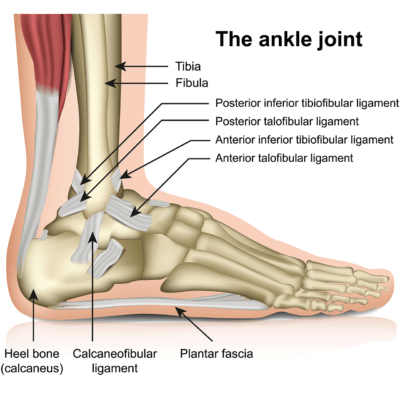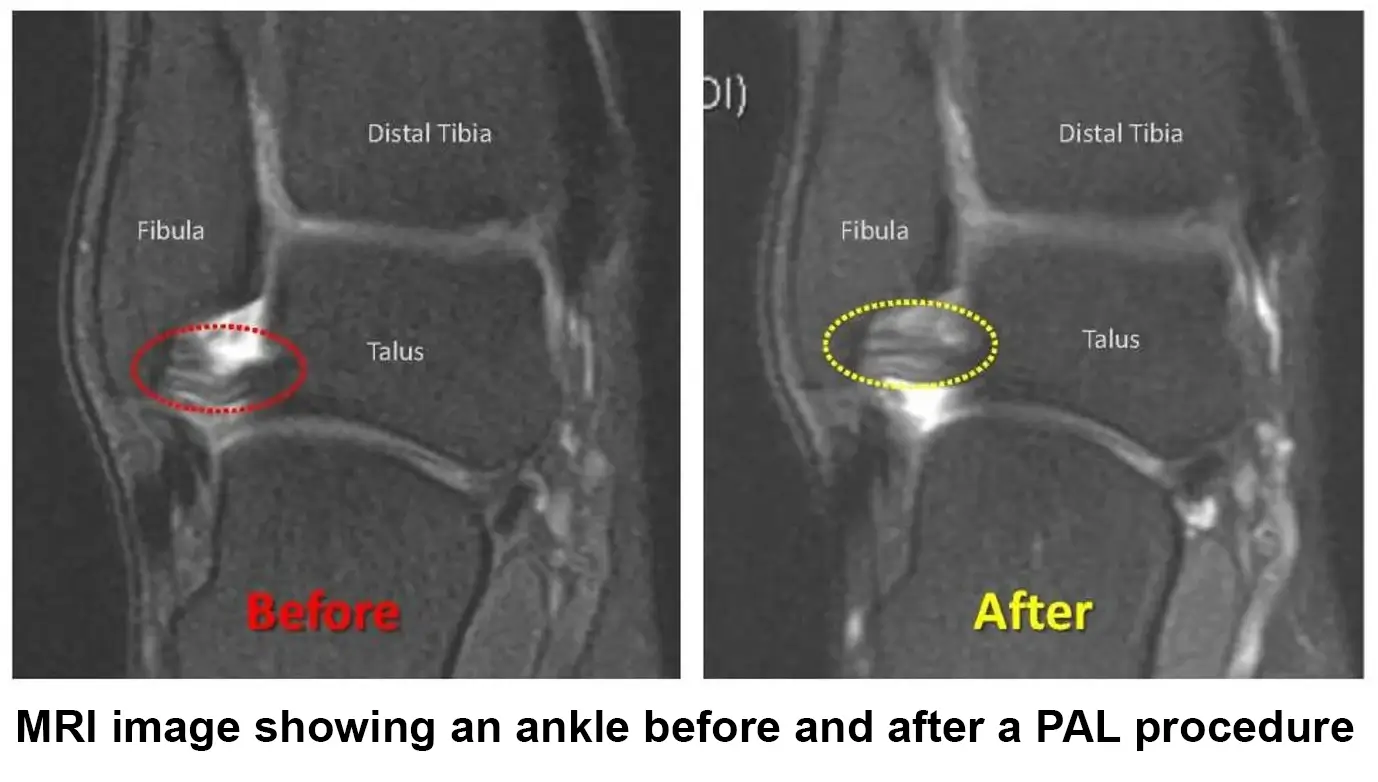Understanding Ankle Ligament Surgery

Medically Reviewed By:
Ankle ligament injuries often occur during sports, physical activities, or even simple missteps. A torn ankle ligament happens when the fibrous tissue connecting bones in the ankle joint is stretched beyond its limit, leading to pain, instability, and difficulty walking. These injuries can significantly impact mobility, making daily activities challenging and increasing the risk of future ankle problems if left unaddressed.
When non-surgical approaches such as rest, physical therapy, and bracing do not provide sufficient relief, physicians may recommend surgery to repair or reconstruct the damaged ligament. Ankle reconstruction surgery aims to restore stability and function to the ankle joint, allowing individuals to regain mobility after recovery.
This article covers key details of ankle ligament surgery, including its benefits and what patients can expect during recovery.
Most Frequently Torn Ankle Ligaments

The ankle is stabilized by several important ligaments that connect the bones and allow for smooth, controlled movement. When an ankle ligament is torn, it is most commonly the ligaments on the outside (lateral side) of the ankle that are affected.
These lateral ligaments play a crucial role in maintaining ankle joint stability while allowing flexibility and movement, especially during activities that involve twisting or sudden direction changes.
The most frequently injured ligaments in the ankle are the anterior talofibular ligament (ATFL), the calcaneofibular ligament (CFL), and the posterior talofibular ligament (PTFL). (1)
These ligaments form a supportive network that connects the fibula to the talus and calcaneus (heel bone), helping to limit excessive outward rolling of the ankle, a common motion during sprains.
The anterior and posterior tibiofibular ligaments, positioned higher up on the ankle, are also vulnerable to injury. These ligaments help stabilize the joint between the tibia (shinbone) and fibula, vital in maintaining ankle integrity during weight-bearing movements.
Different Types Of Ligament Tears
Ankle ligament tears can vary in severity, depending on the extent of the damage to the ligament fibers. The type and severity of the ligament tear often determine the approach for managing the condition, including whether surgery is necessary.
Partial Ligament Tear
A partial ligament tear occurs when only a portion of the ligament’s fibers are damaged, but the ligament remains intact. This type of tear is commonly called a Grade 2 sprain. It is often associated with moderate pain, swelling, and difficulty bearing weight on the affected ankle.
Partial ligament tears typically respond well to non-surgical approaches. Rest, ice, compression, and elevation (RICE) are often recommended in the acute phase, followed by physical therapy to restore strength and stability to the ankle.
Complete Tear (Intact)
A complete ligament tear, or a Grade 3 sprain, occurs when the ligament is fully torn but remains connected to the bone at both ends. This type of injury results in significant pain, swelling, bruising, and a noticeable loss of ankle stability.
Although the ligament is fully torn, it may still heal without surgery in some cases. Conservative options such as immobilization with a brace or cast and a structured physical therapy program are often recommended first. However, surgery may be considered if the ankle remains unstable after healing.
Complete Tear (Retracted)
A complete tear with retraction occurs when the ligament fully tears and pulls away from the bone, separating the ends. This type of injury often causes a high degree of functional impairment, making walking or daily activities difficult.
Physicians may discuss surgical options to help restore function in cases of a retracted ligament tear, as natural healing may be limited.
Ankle Reconstruction Surgery For Torn Ligaments
The most common ankle ligament surgery involves drilling holes in the bones and rerouting tendons to replace the damaged ligaments (2). The tendon can be sourced from either the patient or a donor.
While commonly used, some research suggests that surgery is not always more effective than physical therapy (3). Reported complications include nerve injury (6-11% of cases) (4), with surgical complication rates ranging from 8% (open surgery) to 15% (arthroscopic surgery) (5).
Additionally, 7-9% of patients who undergo lateral ankle reconstruction may require a second surgery due to failure of the initial procedure (6).
How Long Is The Recovery From An Ankle Surgery?
In a recent study, athletes with only an ankle ligament tear returned to training as early as seven to 16 weeks (with an average of 9 weeks) after a lateral ankle ligament reconstruction procedure (3).
Return to sports took slightly longer, ranging from 7 to 22 weeks (with an average of 11 weeks). If there was an additional injury, such as a cartilage tear in the main ankle joint, the average return to training was 12 weeks, and the return to sports was 15 weeks.
Exploring Alternatives: The Percutaneous Ankle Ligamentoplasty (PAL) Procedure
A surgical graft may not be necessary for most patients with partial or complete tears where the ligament remains intact. Physicians in the licensed Regenexx network offer a percutaneous ankle ligamentoplasty (PAL) procedure using Regenexx injectates.
This procedure involves image-guided injections using the patient’s own bone marrow concentrate, which contains signaling cells that may help support the body’s natural repair processes. The PAL procedure has been performed for over a decade, with imaging (as demonstrated in the example of an early before-and-after MRI below) showing structural improvement following treatment.

The MRI shows that the calcaneofibular (CF) ligament, indicated by the dashed oval, improves its appearance after the PAL procedure—all without surgery. This outcome requires specialized training and the use of the patient’s own bone marrow concentrate containing mesenchymal stem cells. To learn more about this procedure, watch the video below:
Conditions Addressed By The Regenexx PAL Procedure
Physicians in the licensed Regenexx network may offer the PAL procedure to support ankle stability in cases of:
- Recurrent Ankle Sprains: Frequent sprains cause instability and weaken ankle ligaments.
- Ankle Ligament Laxity: Looseness or overstretching of ligaments leads to reduced ankle stability.
- Post-traumatic Ankle Instability: A previous injury, such as a sprain or fracture, can cause ongoing instability.
- Functional Ankle Instability: Difficulty maintaining balance due to weakened ligaments can often be felt during movement.
- Chronic Ankle Instability: Ongoing ankle weakness and instability can result from repeated sprains or ligament damage.
How Can Bone Marrow Concentrate Support Ligament Healing?
Bone marrow concentrate (BMC), which contains mesenchymal signaling cells, plays a role in supporting the body’s natural repair mechanisms. These cells help coordinate the healing process by releasing signals that may aid in ligament recovery.
When BMC is introduced into a damaged ligament, it promotes a coordinated repair response by signaling other healing cells to the injury site. This approach may support tissue integrity and function over time.
Research-Based Orthobiologics: Understanding The Regenexx PAL Approach
With the growing interest in orthobiologic treatments, many clinics and providers offer a range of procedures under various names. The terminology and approach to these treatments can vary, and patients are encouraged to evaluate their options carefully.
To make informed decisions, seeking out research-supported procedures from reputable sources is essential. Physicians in the licensed Regenexx network adhere to strict standards and use bone marrow concentrate processed using Regenexx lab processes. This interventional orthobiologic approach offers a non-surgical option for ligament injuries.
While severe injuries may require surgery, those with torn ankle ligaments may benefit from the PAL procedure, supporting the body’s natural repair processes. This approach may reduce the need for more invasive surgical options, such as tendon grafts. The PAL procedure is a research-backed solution that may support ligament healing without the risks of surgery.
Choose The Right Approach For Your Ankle Ligament Tear
When addressing ankle ligament injuries, it’s important to evaluate all available options. While surgery may be necessary for severe cases, many individuals may benefit from non-surgical options.
Physicians in the licensed Regenexx network offer interventional orthobiologic procedures such as PAL, which may provide a non-surgical option for individuals seeking to support ankle function and stability without invasive surgery.
Ready to explore advanced, non-surgical options for ankle ligament injuries? Learn how physicians in the licensed Regenexx network may be able to help you explore potential alternatives.
________________________________________
References:
- Manganaro D, Alsayouri K. Anatomy, Bony Pelvis and Lower Limb, Ankle Joint. [Updated 2019 Aug 3]. In: StatPearls [Internet]. Treasure Island (FL): StatPearls Publishing; 2019 Jan-. Available from: https://www.ncbi.nlm.nih.gov/books/NBK545158/
- Porter DA, Kamman KA. Chronic Lateral Ankle Instability: Open Surgical Management. Foot Ankle Clin. 2018 Dec;23(4):539-554. doi: 10.1016/j.fcl.2018.07.002.
- Kerkhoffs GMMJ, Handoll HHG, de Bie R, Rowe BH, Struijs PAA. Surgical versus conservative treatment for acute injuries of the lateral ligament complex of the ankle in adults. Cochrane Database of Systematic Reviews 2007, Issue 2. Art. No.: CD000380. DOI: 10.1002/14651858.CD000380.pub2.
- Early recovery after arthroscopic repair compared to open repair of the anterior talofibular ligament for lateral instability of the ankle. Matsui K, Takao M, Miyamoto W, Matsushita T. Arch Orthop Trauma Surg. 2016 Jan; 136(1):93-100. https://www.ncbi.nlm.nih.gov/pubmed/26467354/
- Guelfi M, Zamperetti M, Pantalone A, Usuelli FG, Salini V, Oliva XM. Open and arthroscopic lateral ligament repair for treatment of chronic ankle instability: a systematic review. Foot Ankle Surg. 2018 Feb;24(1):11-18. doi: 10.1016/j.fas.2016.05.315.
- Yasui Y, Murawski CD, Wollstein A, Kennedy JG. Reoperation rates following ankle ligament procedures performed with and without concomitant arthroscopic procedures. Knee Surg Sports Traumatol Arthrosc. 2017 Jun;25(6):1908-1915. doi: 10.1007/s00167-016-4207-x.

Medically Reviewed By:
